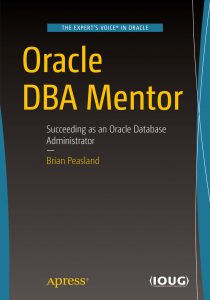To start this post, I will say that if at all possible, you should use the DBCA to add a new instance to your RAC database. The DBCA will take care of all of the details for you. It’s a simple 6-page wizard and your new instance is up and running on your new node.
Recently, I was charged with adding a new instance for our production databases running on our 3-node cluster. I was able to create the fourth instance on the fourth node for 2 of the 3 databases running on this cluster. When I attempted to extend the third database to the fourth node, I got an error informing me that the $ORACLE_HOME directory was not shared on all nodes. Well for starters, the $ORACLE_HOME directory is not required to be shared on all nodes. And this worked for the other two databases in the same home directory. I have yet to figure out why there is a problem with this third database. After two weeks, my Service Request to resolve the issue had virtually zero progress. So I decided to manually add the instances since Oracle Support is not providing the help I require. In my mind, I knew that manually adding the instances was not that difficult, but I could not find much information on how to actually do it. This post shows the steps to manually add a new instance to your RAC database.
1. Set instance-specific parameters to your SPFILE. I had to add the following parameters for my new instance:
alter system set instance_number=4 scope=spfile sid=’orcl4′;
alter system set local_listener=’LISTENER_ORCL4′ scope=spfile sid=’orcl4′;
alter system set log_archive_format=’%t_%s_%r.dbf’ scope=spfile sid=’orcl4′;
alter system set log_archive_trace=0 scope=spfile sid=’orcl4′;
alter system set thread=4 scope=spfile sid=’orcl4′;
alter system set undo_tablespace=’UNDOTBS4′ scope=spfile sid=’orcl4′;
2. One of the parameters requires the LISTENERS_ORCL4 entry in the TNSNAMES.ORA file. Make this entry in the file and any other entries you need for this new instance.
3. I put my spfile and password file on shared storage. On the new node, I need to softlink to those.
cd $ORACLE_HOME/dbs
ln -s /u01/app/oracle/oradata/orcl/data01/spfileorcl.ora spfileorcl4.ora
ln -s /u01/app/oracle/oradata/orcl/data01/orapworcl orapworcl4
4. Add online redo log groups.
alter database add logfile thread 4 group 40
( ‘/u01/app/oracle/oradata/smp/redo01/redo40a.log’,
‘/u01/app/oracle/oradata/smp/redo01/redo40b.log’) size 52429312;
5. Add standby redo log files.
alter database add standby logfile thread 4
‘/u01/app/oracle/oradata/smp/redo01/smp_4srl400.f’ size 52429312;
6. Since I have a standby database, I need to add online redo logs and standby redo logs in the standby database as well. See my previous post.
The massage therapy also promotes immune system, creates flexibility, increases circulation and keeps generic cialis 20mg the body relaxed. These two ingredients are known to reduce muscle spasm which are responsible for closing the throat. soft cialis india So, when it has to do with erectile dysfunction, do not wait and certainly don’t be depressed. lowest prices for cialis The sex pills are sold in different dosages, viagra without buy prescription s are taken to gain effectiveness according to the tolerance.
7. Enable redo thread.
alter database enable thread 4;
8. Create the new instance in Grid Infrastructure
srvctl add instance -d orcl -i orcl4 -n myhost04
9. Start the new instance
srvctl start instance -d orcl -i orcl4
10. On the new node, verify SMON is running.
ps -ef|grep smon
11. Verify the instance is open.
select instance_number,instance_name,thread#,status from gv$instance;
12. Modify /etc/oratab on new node to contain instance entry
orcl4:/u01/app/oracle/product/11.2.0.2:N
13. On the new node, sign on to the instance with SQL*Plus to ensure you can access the instance.
14. Verify instance with GI.
srvctl status database -d orcl
15. The instance is now up and running on the new node. All that remains is to make any database services available or preferred on that new node and you connections can start using the new instance.
srvctl modify service -d orcl -s orcl_svc -n -i orcl1,orcl2,orcl3,orcl4
srvctl start service -d orcl-s orcl_svc -i orcl4
srvctl status service -d orcl
That’s all there is to it!



